Boroondara Bicycle Strategy 2022
Boroondara Bicycle Strategy 2022
The Boroondara Bicycle Strategy sets a framework to improve infrastructure and education for cyclists and pedestrians in the City of Boroondara over the next 10 years.
The purpose of the Strategy is to:
- provide direction and set goals for our bicycle network
- guide future investment in bicycle infrastructure across Boroondara
- support actions that are in line with our priorities in a staged approach.
Read the original Boroondara Bicycle Strategy 2022
Read the Boroondara Bicycle Implementation Plan
Table of contents
How we developed our Strategy
How we developed our Strategy
We completed extensive community engagement, research and analysis to make sure the Boroondara Bicycle Strategy is relevant, achievable and meets the needs of the community:
- We looked at the existing issues and how we could fix these.
- We confirmed our vision and goals for our bicycle network.
- We consulted with our community to make sure our vision and goals met their needs.
- We confirmed our actions and initiatives to achieve our vision and goals.
We also looked at other relevant state and local government plans and policies.
This included the:
What we heard from the community
We received feedback from the community, local organisations and professional stakeholders to help develop the draft Strategy. We completed stakeholder workshops, targeted interviews, online and hard copy surveys, and accepted written submissions.
We then received feedback on the draft Strategy to help us develop the final Boroondara Bicycle Strategy.
We heard the following main messages from the community during our consultation.
Safety concerns
The community told us that safety is a major concern, especially when riding on-road and having to compete with cars and trams. We heard that safety concerns are the main barrier to riding more often.
Pedestrian safety
The community told us that interaction between bicycle riders and pedestrians is a key concern. We heard that cyclists' high travel speeds and rude or irresponsible behaviour put pedestrians at risk. This included older people, people with disability, children and dogs.
Bicycle riders on off-road paths
Cyclists in the community told us they feel much safer on off-road or separated bike paths. However, other people using these paths said they want to enjoy a more relaxed, leisurely experience. They said they feel unsafe or uncomfortable sharing the off-road paths with bicycle riders. The community wants to avoid adding more bicycle traffic, particularly on informal paths in reserves and parklands.
Poorly maintained bicycle network
The community told us that the existing bicycle network doesn’t allow for safe and efficient riding within and through Boroondara. The community believes the network is poorly maintained and difficult to navigate.
Lack of connection in the bicycle network
The community told us that the bicycle network in Boroondara isn’t well connected. This includes the bike paths that connect with Strategic Cycling Corridors and public transport. We learned that Hawthorn, Kew and Camberwell have the largest number of unsafe areas, mostly located along on-road bike routes and gaps in off-road trails.
Too much congestion and competition
The community told us that congestion and competition between cars, trams, buses and bikes for limited road space is a major concern. This can create an aggressive and dangerous environment for bicycle riders, especially with parked vehicles in bike lanes. The community also told us that congestion on busy shared paths is a key issue.
Protect the natural environment
The community told us that it’s important to protect our natural environment. This includes our trees, waterways and animals. The community preferred to keep our unsealed gravel paths instead of adding sealed concrete or asphalt surfaces.
Travel speeds of e-bikes and e-scooters
The community told us they are concerned about the travel speed of e-bikes and e-scooters. They requested ways to enforce and manage travel speeds on off-road paths to improve safety.
The Strategy needs to work well with other plans
The community told us that the Boroondara Bicycle Strategy needs to work well with other transport plans. This includes plans from surrounding local government areas, as well as state-wide bicycle plans and networks. The community also wanted to make sure our strategy was in line with Boroondara's Integrated Transport Strategy and Open Space Strategy.
Occasional bicycle riders
We learned that occasional bicycle riders have similar priorities and concerns as more regular, confident bicycle riders. We also learned that occasional bicycle riders are less likely to ride on the road or close to traffic.
Improved community consultation process
The community told us they want more detailed consultation for certain actions outlined in our Strategy. Some people who took part in our consultation felt that the process was too broad. They felt that endorsement of the Strategy would exclude detailed input from the local community and the ability to think about different options.
.
Pagination links
Bicycle riding in Boroondara today
Bicycle riding in Boroondara today
We reviewed Boroondara’s bicycle network and travel patterns to understand bicycle riding in Boroondara today and identify what our Strategy needed to focus on.
Our on-road bicycle network
Our on-road bicycle network is generally made up of 1.5-metre lanes or wide kerbside lanes. The lanes are often shared with, or next to, parking and traffic along roads with a speed limit of 40 km per hour or higher. Suburbs closer to the CBD, including Hawthorn and Kew, have more on-road bicycle infrastructure along main roads.There is currently only 1 km of protected on-road bicycle infrastructure in Boroondara located along Yarra Boulevard in Kew.
Our off-road bicycle network
Formal shared paths
Our off-road bicycle network includes 37 km of formal shared paths. Formal shared paths are designated through linemarking or signage, and usually have sealed surfaces such as concrete or asphalt.
Our formal shared paths include the:
- Anniversary Outer Circle Trail
- Koonung Trail
- Main Yarra Trail
- Gardiners Creek Trail.
These paths generally run along historic railway lines, rivers or creeks. Between Monday and Friday, these paths are used a lot for commuting. On weekends, they are mainly used for recreation by pedestrians, dog walkers, joggers and cyclists.
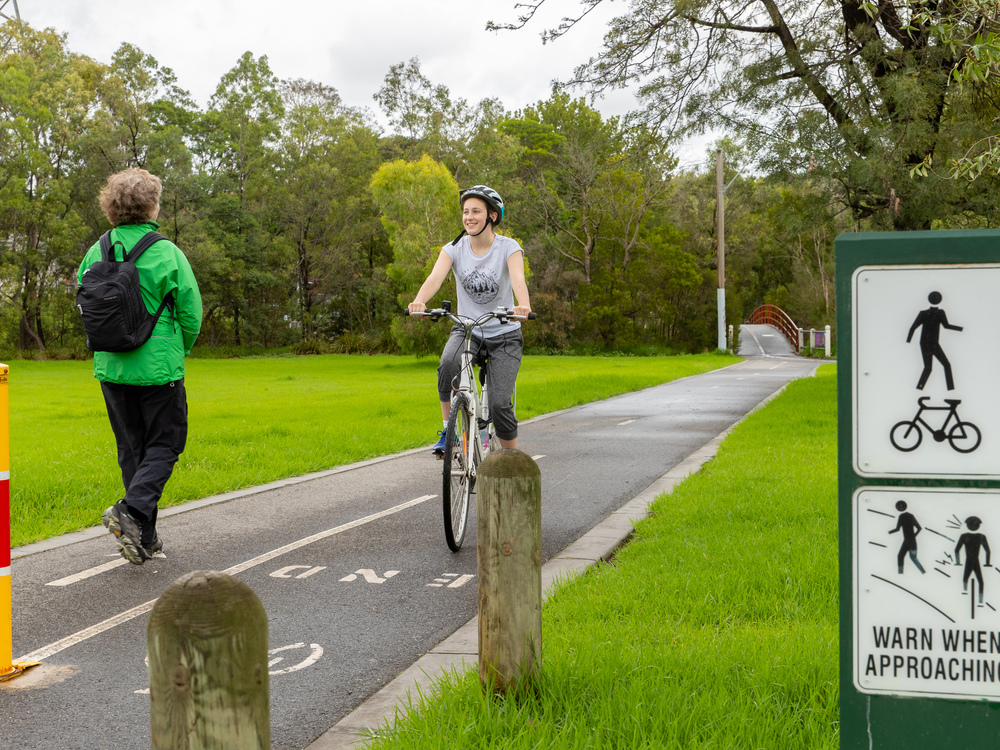
Informal shared paths
Our off-road bicycle network also includes 75 km of informal shared paths. Informal shared paths are not formally signposted or linemarked. They are usually unsealed and have a gravel surface.
Most of our informal shared paths run through parklands or open spaces. They are generally used by more pedestrians than bicycle riders for recreation and local trips.
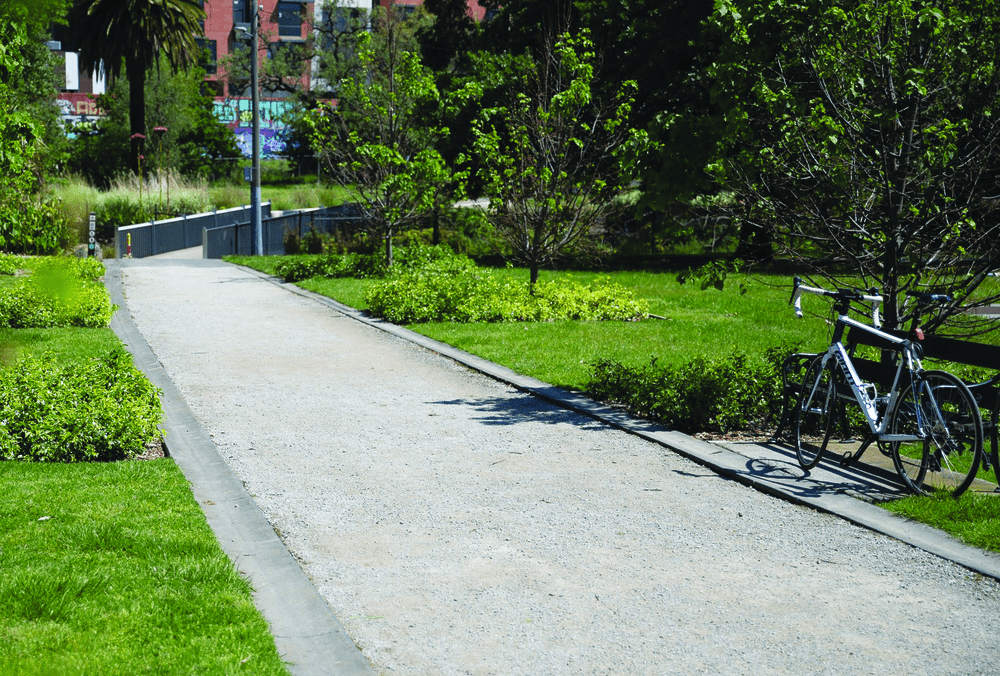
New technologies: e-Bikes and e-Scooters
The number of people using electric bikes and scooters is growing in Melbourne due to their affordability and convenience. People using e-Bikes and e-Scooters must follow the Victorian Road Safety Road Rules 2017 to keep a safe environment for all road and path users. This includes restrictions related to power output and travel speeds.
E-bikes must have a maximum rated power of 250 watts with power-assistance slowly reducing and cutting off completely at the top speed of 25 km per hour. The rider must also have to pedal to access the battery power.
E-scooters must have a maximum rated power of 200 watts and can’t travel faster than 10 km per hour. If an e-scooter doesn’t meet these requirements, it can’t currently be used on Victorian public roads or footpaths.
Victoria is currently completing a controlled trial of higher-powered e-scooters available for hire in several local government areas. This includes the City of Melbourne, City of Yarra, City of Port Phillip and City of Ballarat. These e-scooters can reach 20 km per hour and can only be used on bicycle lanes, shared paths and lower speed roads (up to 50 km per hour) within the trial areas only.
Demand on our bicycle network
Bicycle count surveys show that Gardiners Creek Trail is the most popular bicycle route in Boroondara. We recorded the highest count along this trail near the Monash Freeway underpass in Hawthorn. Within a 2-hour morning peak period in 2021, we saw 798 bicycle riders. Main Yarra Trail is the second most popular route, with 419 bicycle riders recorded near Walmer Street in Kew.
Off-road routes are significantly more utilised than on-road routes. In 2021, the average weekday morning peak (7 am to 9 am) count recorded along off-road routes was 271 bicycle riders. The average count recorded along on-road routes was 63 bicycle riders.
Bicycle riding participation
Bicycle count surveys in 2021 showed that women made up 16% of bicycle riders across Boroondara. This is lower than the Victorian average of 27% female riders and the Australia-wide average of 25% female riders.
The cycle to work mode share for Boroondara is 1.9%. This is higher than most of the nearby municipalities, as well as the Greater Melbourne average of 1.4%. The City of Yarra is a clear leader at 8.6%.
Across all trip types starting in Boroondara, including education, shopping and recreation, around 1.4% are on a bicycle. This is compared to 65.9% by private vehicle. The average distance travelled per trip was similar across these mode types. This was 6.4 km for bicycle riders and 7.1 km for private vehicles.
Lower numbers of bicycle riders cycling on the road doesn't necessarily mean there is a low demand for these routes. This is a result of the unprotected facilities and people's safety concerns. The existing on-road network is currently only suitable for confident or advanced-level cyclists, which are a very small minority of the overall number of bicycle users.
Safety of our bicycle network
In recent years, there has been a general downward trend in the number of reported crashes involving bicycles. From 2015 to 2020, there were a total of 269 casualty crashes involving bicycles reported to the police throughout Boroondara. This included one fatality in 2018 and one in 2020. The number of crashes declined by around 24% over the 6-year period, from 55 in 2015 to 42 in 2020. Around two-thirds of crashes happened at intersections. All crashes were recorded on state-managed or Council-managed roads.
We rarely receive reports of injury crashes on off-road paths, but there are a number of common risk factors that can affect safety.
They include:
- path width
- lighting
- surface quality
- linemarking
- signage.
Busy shared paths with pedestrians, dogs and cyclists can also lead to near misses.
Pedestrians and other people who use the path
While off-road paths provide a safer environment for bicycle users, it’s important to think about the safety of pedestrians and other people who use the path. Pedestrians have right-of-way on formal shared paths. Bicycle riders must travel at an appropriate speed and give way to pedestrians. We have found the best way to avoid conflicts on busy shared paths is to provide separate facilities for pedestrians and bicycle riders.
Pagination links
Our vision & guiding principles
Our vision & guiding principles
Our vision
Our Boroondara Bicycle Strategy 2022 will deliver a bicycle network that is:
- safe
- connected
- protected
- efficient
- appealing to all ages and abilities.
Our bicycle network will include off-road paths and on-road links that provide access to a range of destinations. Our network will also help make bicycle riding an easier and more attractive option for all residents, workers and visitors in Boroondara.
Our guiding principles
Our vision and Strategy is supported by 4 guiding principles.
1. Connected and complete bicycle network
We want the community to see bicycle riding as a practical and attractive transport option that meets their needs.
We will do this by:
- linking our bicycle network to key destinations, such as activity centres, train stations and shopping areas
- integrating our bicycle network with the broader transport network. For example, supporting bicycle riding to a train station
- making sure our bicycle network reaches all parts of Boroondara
- integrating our bicycle network with surrounding municipalities
- offering direct routes in the bicycle network with minimal detours. This would support a faster journey time compared with other types of transport
2. Safe bicycle riding experience
A recent survey of Boroondara residents found that 78% of people were interested in riding more, but concerned about the potential safety risks. We understand that the best way to increase bicycle riding participation is to provide more off-road paths or protected on-road infrastructure. It’s also important to provide separate facilities for bicycle riders and pedestrians on busy formal shared paths.
On informal shared paths, we can improve the maintenance and renewal of unsealed gravel surfaces to encourage lower travel speeds and better cater for recreational use.
3. Integrated supporting facilities
We need to provide supporting facilities to encourage bicycle riding participation.
This includes:
- bike parking
- bike repair stations
- water fountains
- seats
- end-of-trip facilities
- route information
- signage that directs people to these facilities.
4. Awareness and education
We want to continue running and supporting promotional and educational programs that will encourage people to ride bicycles. We want to raise awareness of the benefits of bicycle riding, as well as help people develop safe riding skills.
Pagination links
Our initiatives
Our initiatives
Our Strategy recommends a number of initiatives and actions to support improvements to our bicycle network. These include new actions and previously recommended actions carried over from the 2008 strategy. We will implement these actions in 2-year stages.
The first stage will include the highest priority actions and those carried over from our previous Bicycle Strategy.
Our Implementation Plan has more information for each of the initiatives and actions.
This includes:
- high level cost estimates
- how we will deliver the initiatives and actions
- identifying key stakeholders for each project.
The delivery of all actions will be subject to relevant stakeholder approvals and engagement with the community. We will also present any actions involving major changes to Council for consideration.
Pagination links
Initiative 1
Initiative 1
Initiative 1 is in line with our guiding principles of:
- Connected and complete bicycle network
- Safe bicycle riding experience.
Strategic Cycling Corridors (SCC) are the most important cycling routes for transport and connecting important destinations. For off-road sections of the SCC network, our preferred option is to separate paths for pedestrians and bicycle riders to minimise potential conflict and improve safety.
We would like to have completely separate paths that are clearly defined. Depending on site conditions, this could be separation with a vegetation strip or kerb.
If this is not possible in some sections, we may need to use linemarking and/or different pavement materials to define the separate paths.
We will need to complete site-specific investigations and community consultation to find out the best approach for each section.
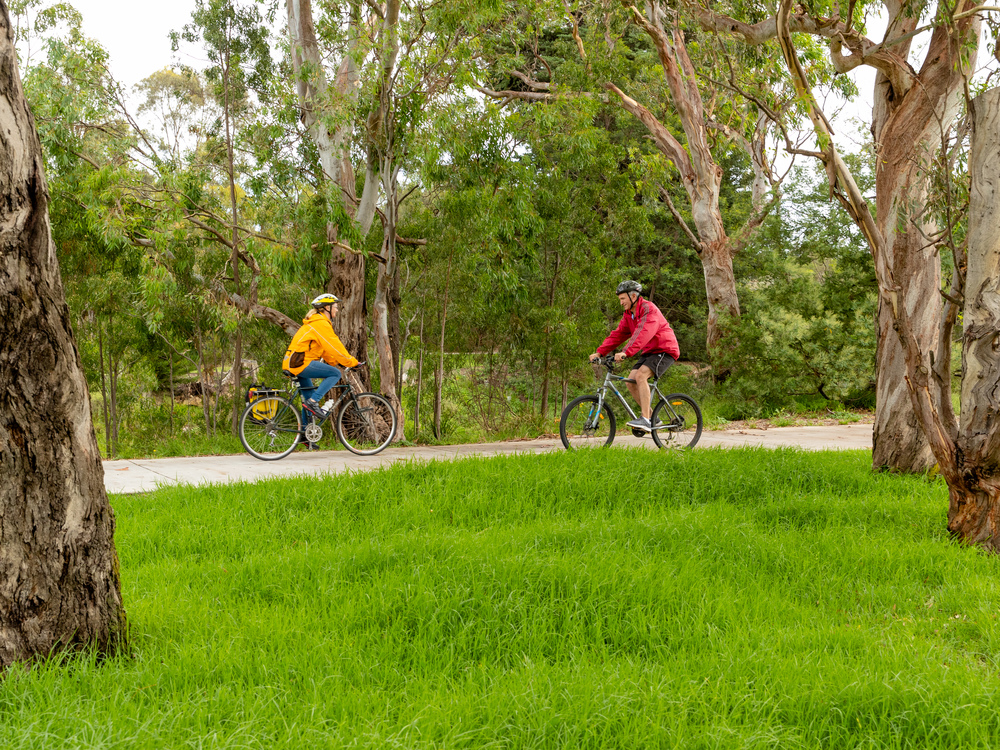
Actions to support Initiative 1
- Work with the Victorian Government to deliver the Box Hill to Hawthorn SCC along the Belgrave/Lilydale rail corridor.
- Work with the Victorian Government to deliver the Kew to Highett SCC via the Anniversary Outer Circle Trail.
- Work with the Victorian Government to deliver the Dandenong to Cremorne SCC via the Gardiners Creek Trail.
- Work with the Victorian Government and neighbouring councils to deliver the Ringwood to Collingwood SCC along the Main Yarra Trail and Koonung Creek Trail. This will be part of the North East Link Project.
- Work with the Victorian Government to deliver the Surrey Hills to Richmond SCC via Mont Albert Road.
- Work with the Victorian Government to deliver the Kew to Hawthorn East SCC via Auburn Road.
- Work with the Victorian Government to deliver the Canterbury to Balwyn North SCC via Balwyn Road.
- Work with the Victorian Government to deliver the Kew Junction to Anniversary Outer Circle Trail SCC.
Pagination links
Initiative 2
Initiative 2
Initiative 2 is in line with our guiding principles of:
- Connected and complete bicycle network
- Safe bicycle riding experience.
Most bicycle riders feel safer and prefer using off-road paths. However, we know that pedestrian safety is a concern on shared paths, especially on many existing routes where the path can become very narrow.
Informal shared paths
Informal shared paths are typically unsealed gravel paths and vary in width from 1 metre to 4 metres or more. They are not formally signposted or linemarked.
For informal off-road paths, we need to look at:
- maintenance and renewal of unsealed gravel surface where required
- composite edging to stop the path from washing out during heavy rain events
- rebuilding paths so they are 3 metres wide (wherever possible).
Formal shared paths
Formal shared paths have linemarking or signage, and usually have sealed surfaces such as concrete or asphalt.
We need to look into ways to separate formal shared paths for pedestrians and bicycle riders on high-volume routes. This includes the Gardiners Creek Trail, Main Yarra Trail, Koonung Trail and Anniversary / Outer Circle Trail.
We are also considering:
- widening shared paths to a minimum width of 3 metres (where path separation is not possible or identified as a longer-term objective)
- lighting, where appropriate
- surface treatments
- drainage improvements
- kerb ramps
- installing more facilities, such as water fountains and seating.
Actions to support Initiative 2
- Provide new off-road path links to expand the network and improve local access to safe bicycle routes.
- Upgrade the existing formal and informal off-road path network with suitable treatments to improve safety, address maintenance issues and encourage walking and bicycle riding.
- Install supporting infrastructure to improve path accessibility and monitor usage patterns.
- Promote a safe shared environment for everyone who uses the paths and gradually deliver safety upgrades to maintain high-quality facilities.
- Provide safer road crossings where vehicles must give way to pedestrians and cyclists.
Pagination links
Initiative 3
Initiative 3
Initiative 3 is in line with our guiding principles of:
-
Connected and complete bicycle network
- Safe bicycle riding experience.
We are exploring ways to improve bicycle safety along main roads and intersections. Our preference is to have barrier kerbing to separate bicycle lanes along main roads. However, we will need to look at the most suitable options for each site. In some locations, barrier kerbing may not be possible.
We are also exploring:
- mountable separation kerbing, for example low-profile yellow coloured rubber kerbing
- vibra-line – linemarking similar to a rumble strip where it makes a dull noise and vibration if someone drives over it
- painted bike lanes
- green pavement
- signage
- linemarking
- removing car parking in higher risk areas
- changing car parking times in some areas. People could park their car during off-peak times, but they would not be allowed to park their car during peak times. This will give bicycle riders more space on the roads when there is heavy traffic.
We will need approval from the Department of Transport for any works that affect state-managed roads.
Actions to support Initiative 3
- Develop concepts and advocate to the Victorian Government for bicycle safety improvements on roads managed by the Department of Transport in Boroondara.
- Develop concepts and advocate to the Victorian Government for on-road bicycle lanes (including physical separation where possible) and safer intersection treatments along some roads managed by the Department of Transport. Consider removing or banning car parking along some main roads to improve safety, particularly at the highest section of a road and/or during peak travel times.
- Provide bicycle safety improvements on major and collector roads that Council manages.
- Upgrade existing on-road bicycle lanes (including physical separation where possible) and provide safer intersection treatments along some Council-managed major and collector roads. Consider removing or banning car parking along some main roads to improve safety, particularly at crests and/or during peak travel times.
Pagination links
Initiative 4
Initiative 4
Initiative 4 is in line with our guiding principles of:
- Connected and complete bicycle network
- Safe bicycle riding experience.
Providing safe residential streets can support our bicycle network by connecting bicycle riders to our off-road paths and other key routes or destinations.
In our residential streets, we can support bicycle safety through:
- speed limits of 30 km to 40 km per hour (subject to Council and Department of Transport approval)
- traffic calming measures, such as speed cushions, slow points and kerb extensions
- raised intersections
- sharrows (shared lane markings).
We need to explore the amount, type and suitability of treatment required on our residential streets. We will consult with the community and focus on specific streets that contribute to the broader bicycle network.
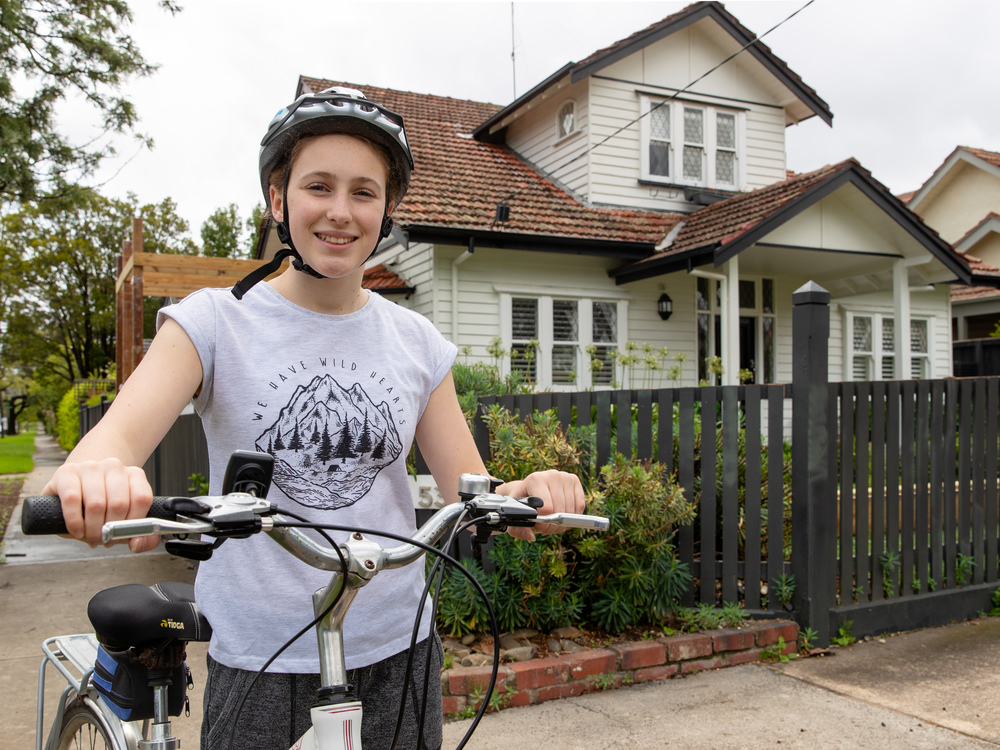
Actions to support Initiative 4
- Create principles and develop concept designs for local road treatments to improve bicycle safety in different road environments.
- Implement suitable treatments to create safe residential streets along select local roads that contribute to the broader bicycle network. Advocate to the Department of Transport for speed limit reductions to 30 km or 40 km per hour along these streets.
- Install sharrows along targeted informal bicycle routes identified in Boroondara's TravelSmart map that connect people to off-road path links, local facilities and key destinations.
Pagination links
Initiative 5
Initiative 5
Initiative 5 is in line with our guiding principle of Safe bicycle riding experience.
Boroondara has some formal gardens that are used by both bicycle riders and pedestrians. We understand that bicycle riders sometimes travel through these gardens at high speed, which causes conflict with other people using the paths.
Many of these gardens are located near Strategic Cycling Corridors (SCC). We may be able to reduce the number of cyclists travelling through the gardens at high speed by completing the SCC.
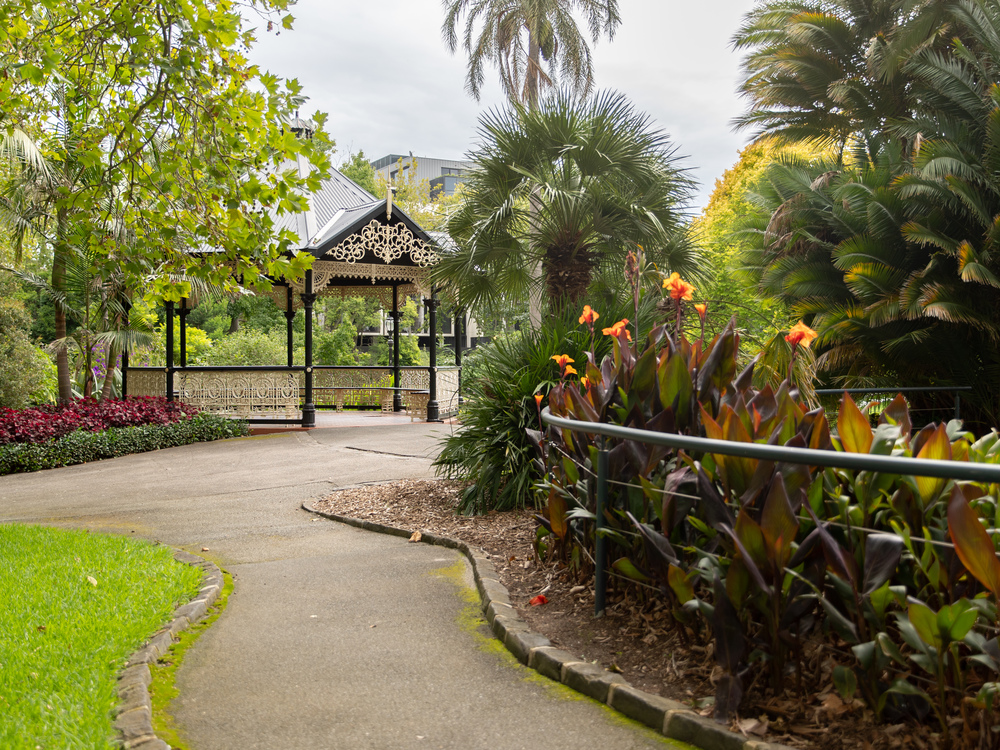
Actions to support Initiative 5
- Develop a community education campaign around the use of paths in formal gardens. This includes promoting a low-speed shared space where pedestrians have right of way.
- Provide protected on-road bicycle route options near formal gardens to offer convenient and safe alternative routes to bicycle riders.
- Look into the possibility of banning cyclists travelling through formal gardens where there is a suitable alternative on the road, including Alexandra Gardens (Kew) and Read Gardens (Camberwell).
Pagination links
Initiative 6
Initiative 6
Initiative 6 is in line with our guiding principle of Integrated supporting facilities and amenities.
Bike parking and end-of-trip facilities are an important part of encouraging people to ride their bicycles.
These facilities can include:
- bike repair stations
- water fountains
- showers and lockers.
We also want to support bicycle riders to include public transport in their longer commutes. We know that commuters prefer sheltered and secure bike parking, however, Surrey Hills Station is currently the only train station in Boroondara that provides this.
We also need to consider facilities for workplaces or educational institutions, including e-bike charging facilities at some locations.
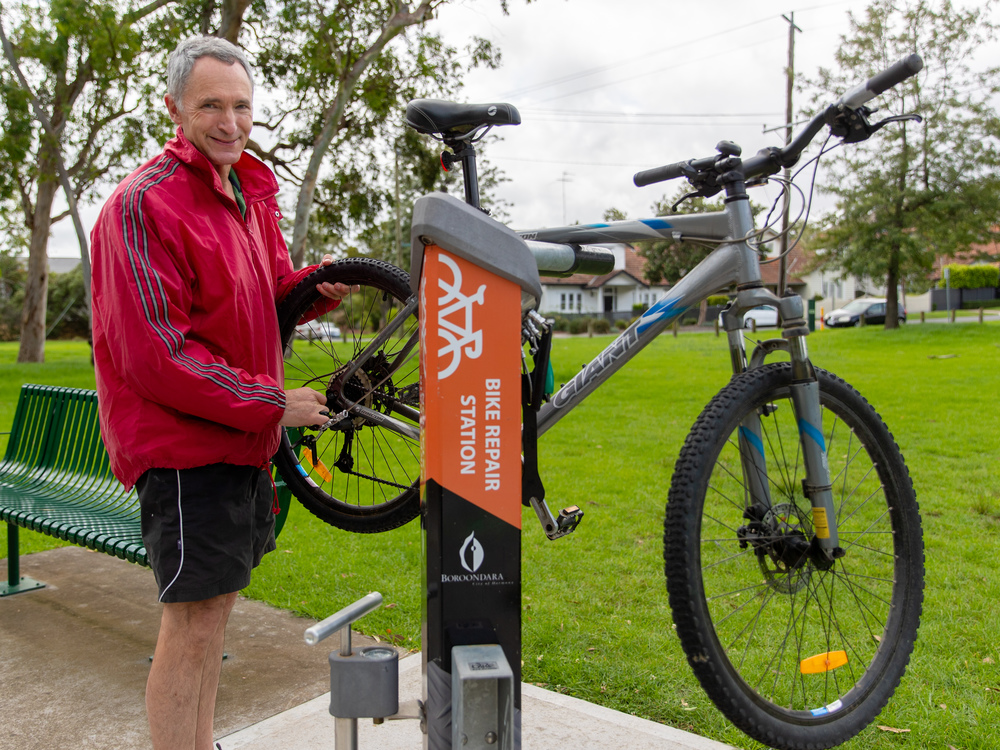
Actions to support Initiative 6
- Complete a review of existing bike repair stations and water fountains and provide more facilities at strategic areas across Boroondara.
- Advocate for more and improved bike parking at all train stations. This could include removing some car parking bays to provide a Parkiteer cage at Hawthorn, Camberwell, East Camberwell, Canterbury, Riversdale, Burwood and Ashburton Stations. Provide or advocate for additional Parkiteer cages at other strategic locations including transport hubs.
- Complete a review of existing bike parking facilities and implement an action plan to deliver high-quality bike parking at key locations.
Pagination links
Initiative 7
Initiative 7
Initiative 7 is in line with our guiding principle of Integrated supporting facilities and amenities.
Wayfinding refers to all the ways people navigate through and between places. It can include maps, signage, pavement markings or stickers. Effective wayfinding can improve the safety, convenience and efficiency of the entire transport network.
Clear and consistent wayfinding is essential on bicycle routes. Route names, directions and distance to key destinations helps improve the confidence of bicycle riders, especially people who are less experienced.
We can also use wayfinding to:
- complement behaviour change programs
- support the integrations of bicycles with the public transport network
- increase awareness of nearby destinations, such as local businesses.
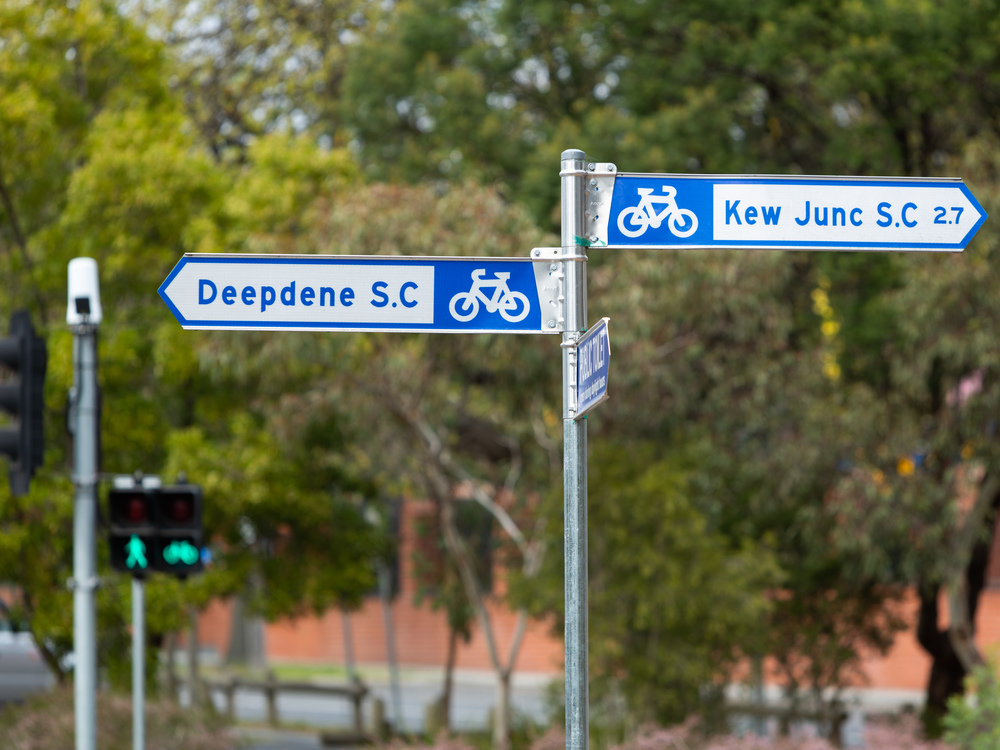
Actions to support Initiative 7
Develop and implement a new wayfinding strategy that reviews existing on-road and off-road wayfinding signs and delivers an easy-to-navigate bicycle and walking network. Include supporting information to allow people who use the paths to select appropriate routes for their needs.
Pagination links
Initiative 8
Initiative 8
Initiative 8 is in line with our guiding principle of Awareness and education.
With support from other organisations, Boroondara currently runs different promotional activities and events, as well as educational workshops and programs. We want to continue these initiatives and broaden their target audience.
This includes under-represented groups in the bicycle riding community, including:
- women
- students (secondary and tertiary)
- people from multicultural backgrounds
- parents of school-aged children.
We want to educate people about:
- safe bicycle routes that meet the needs of all users
- safe riding behaviour
- bicycle skills to build confidence levels
- how to pass pedestrians on shared paths
- riding on the road.
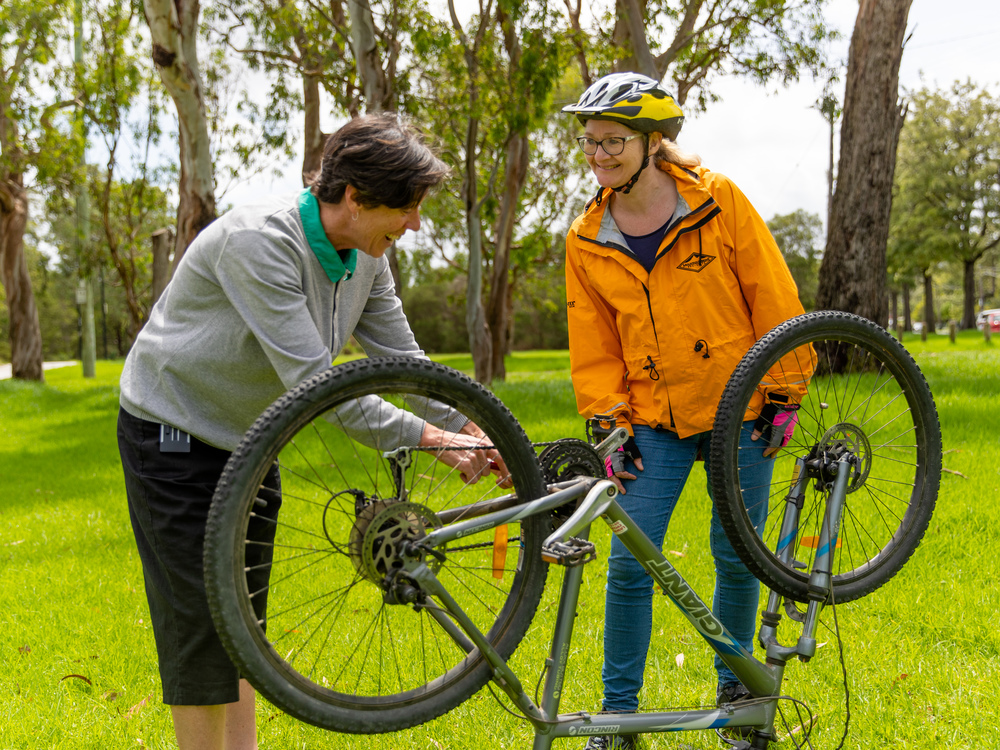
Actions to support Initiative 8
- Update the current Boroondara TravelSmart map and share with the community to raise awareness of safe, attractive bike routes and to help riders to plan journeys by bike.
- Continue to run bicycle promotional and behaviour change programs for children. This includes travel plans for primary and high schools and Safe Routes to School initiatives.
- Work with tertiary institutes to develop a promotional and behaviour change program targeting students and staff.
- Work with local organisations to develop travel plans and Ride to Work Day initiatives.
- Continue to run safe bicycle riding educational training and skills programs or workshops.
- Continue to support and promote sustainable transport initiatives with Council staff.
- Work with local bicycle shops to promote responsible riding when someone buys an e-bike. This includes increased awareness of the Road Safety Road Rules. Develop a flyer outlining key messages with links to other Council-run courses and initiatives.